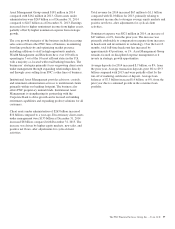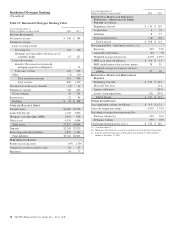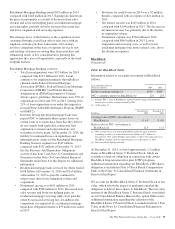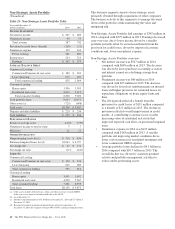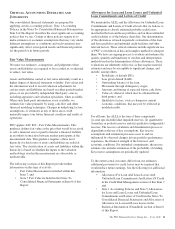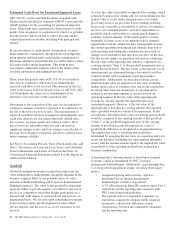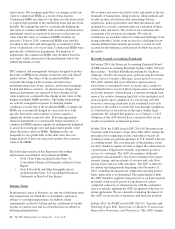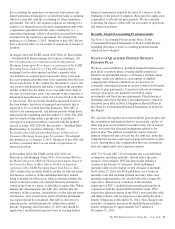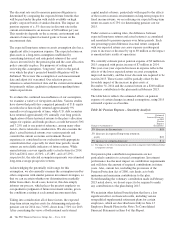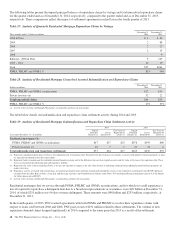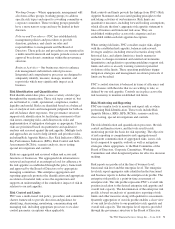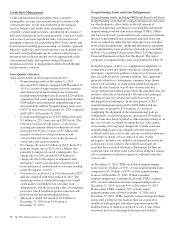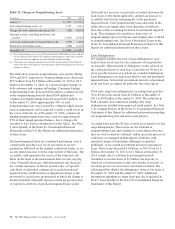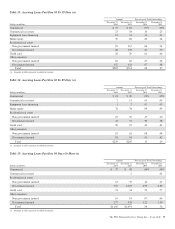PNC Bank 2014 Annual Report Download - page 83
Download and view the complete annual report
Please find page 83 of the 2014 PNC Bank annual report below. You can navigate through the pages in the report by either clicking on the pages listed below, or by using the keyword search tool below to find specific information within the annual report.
the accounting for repurchase-to-maturity transactions and
linked repurchase financings to secured borrowing accounting,
which is consistent with the accounting for other repurchase
agreements. The ASU also requires separate accounting for a
transfer of a financial asset executed contemporaneously with
a repurchase agreement with the same counterparty (i.e.,a
repurchase financing), which will result in secured borrowing
treatment for the repurchase agreement. We adopted this
guidance as of January 1, 2015. Adoption of this ASU did not
have a material effect on our results of operations or financial
position.
In August 2014, the FASB issued ASU 2014-14, Receivables
– Troubled Debt Restructurings by Creditors (Subtopic 310-
40): Classification of Certain Government-Guaranteed
Mortgage Loans upon Foreclosure (a consensus of the FASB
Emerging Issues Task Force). This ASU requires that a
mortgage loan be derecognized and that a separate other
receivable be recognized upon foreclosure when a) the loan
has a government guarantee that is not separable from the loan
before foreclosure; b) the creditor has the intent to convey the
real estate to the guarantor and make a claim on the guarantee
and the creditor has the ability to recover under that claim at
the time of foreclosure; and c) any amount of the claim that is
determined upon the basis of the real estate is fixed at the time
of foreclosure. The receivable should be measured based on
the loan balance (inclusive of principal and interest) that is
expected to be recovered from the guarantor. This ASU is
effective for annual periods, and interim periods within those
annual periods, beginning after December 15, 2014. The ASU
may be adopted using either a prospective or modified
retrospective transition method consistent with the method
elected to adopt ASU 2014-04, Receivables – Troubled Debt
Restructurings by Creditors (Subtopic 310-40):
Reclassification of Residential Real Estate Collateralized
Consumer Mortgage Loans upon Foreclosure. We adopted
this guidance as of January 1, 2015. Adoption of this ASU did
not have a material effect on our results of operations or
financial position.
In November 2014, the FASB issued ASU 2014-16,
Derivatives and Hedging (Topic 815): Determining Whether
the Host Contract in a Hybrid Financial Instrument Issued in
the Form of a Share is More Akin to Debt or to Equity (a
consensus of the FASB Emerging Issues Task Force). This
ASU clarifies that an entity should consider all relevant terms
and features, inclusive of the embedded derivative feature
being evaluated for bifurcation, when evaluating whether the
nature of the host contract in a hybrid financial instrument
issued in the form of a share, is debt-like or equity-like. When
making this determination, the ASU also clarifies that the
substance of the economic characteristics of the relevant terms
and features, and circumstances under which the instrument
was issued should be considered. The ASU is effective for
annual periods, and interim periods within those annual
periods, beginning after December 15, 2015 and should be
applied on a modified retrospective basis to existing hybrid
financial instruments issued in the form of a share as of the
beginning of the period of adoption. Retrospective application
is permitted to all relevant prior periods. We are currently
evaluating the impact of this ASU on our results of operations
and financial position.
Recently Adopted Accounting Pronouncements
See Note 1 Accounting Policies in the Notes To the
Consolidated Financial Statements in Item 8 of this Report
regarding the impact of new accounting pronouncements
which we have adopted.
S
TATUS OF
Q
UALIFIED
D
EFINED
B
ENEFIT
P
ENSION
P
LAN
We have a noncontributory, qualified defined benefit pension
plan (plan or pension plan) covering eligible employees.
Benefits are determined using a cash balance formula where
earnings credits are applied as a percentage of eligible
compensation. Pension contributions are based on an
actuarially determined amount necessary to fund total benefits
payable to plan participants. Consistent with our investment
strategy, plan assets are primarily invested in equity
investments and fixed income instruments. Plan fiduciaries
determine and review the plan’s investment policy, which is
described more fully in Note 13 Employee Benefit Plans in
the Notes To Consolidated Financial Statements in Item 8 of
this Report.
We calculate the expense associated with the pension plan and
the assumptions and methods that we use include a policy of
reflecting plan assets at their fair market value. On an annual
basis, we review the actuarial assumptions related to the
pension plan. The primary assumptions used to measure
pension obligations and costs are the discount rate, mortality,
compensation increase and expected long-term return on plan
assets. Among these, the compensation increase assumption
does not significantly affect pension expense.
ASC 715-30 and ASC 715-60 stipulate that each individual
assumption, including mortality, should reflect the plan
sponsor’s best estimate. PNC has historically utilized a
version of the Society of Actuaries’ (SOA) published
mortality tables in developing its best estimate of mortality.
On October 27, 2014, the SOA published a new study on
mortality rates that included updated mortality tables and
mortality improvement scale, which both reflect longer life
expectancy. Based on an evaluation of the mortality
experience of PNC’s qualified pension plan participants in
conjunction with the updated SOA mortality study, PNC
adopted an adjusted version of the SOA’s new mortality table
and improvement scale for purposes of measuring the plan’s
benefit obligations at December 31, 2014. This change to the
mortality assumption increased the qualified pension plan’s
benefit obligations by approximately $115 million at
December 31, 2014.
The PNC Financial Services Group, Inc. – Form 10-K 65




